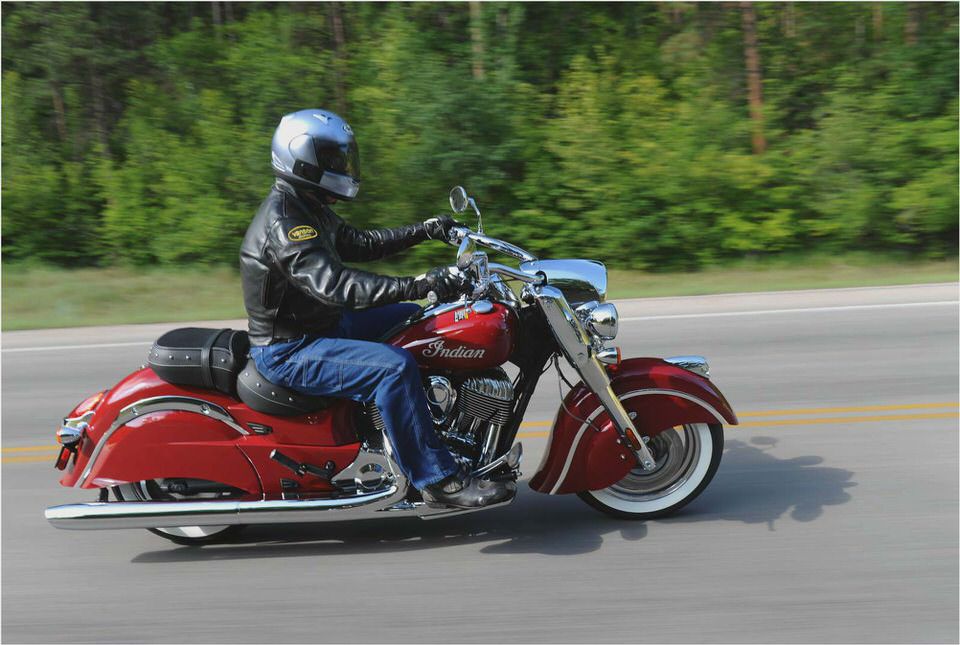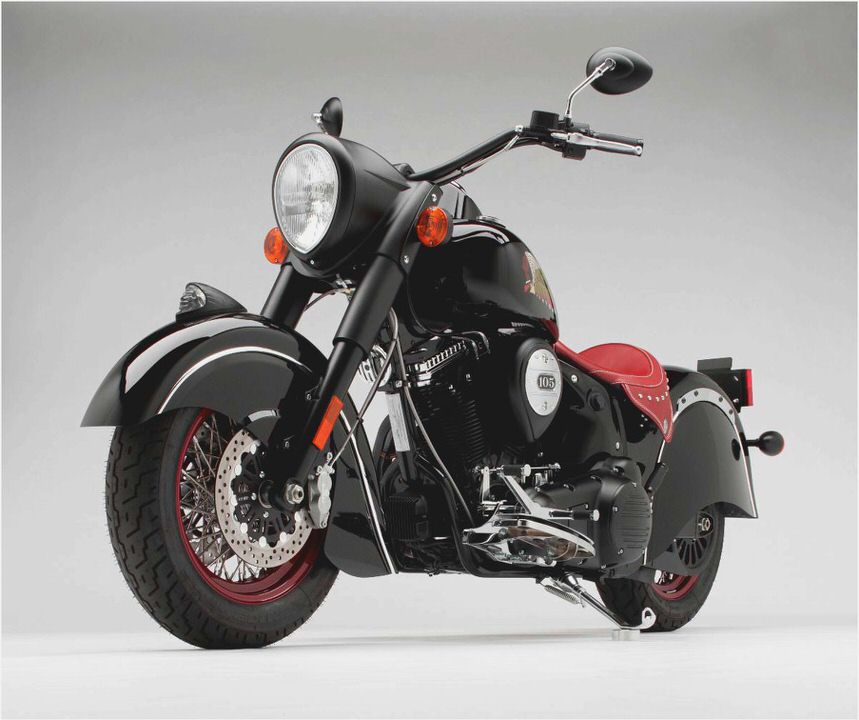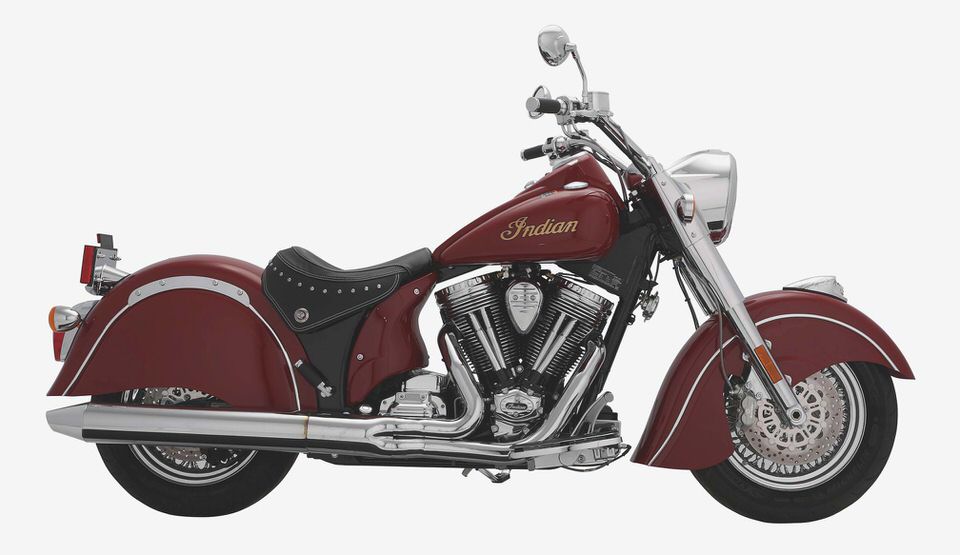
First Ride: 2014 Indian Chief Classic, Vintage and Chieftain
The bare-bones Indian Chief Classic has old-school looks with modern cruiser performance.
Sturgis, South Dakota, the site of the worlds largest motorcycle rally, provided a perfect backdrop for Indian Motorcycles to reveal not one but all three of the new company’s new line of Indian Chief motorcycles, and they did so in front of an enthusiastic gathering of American-brand loyal bikers at the Sturgis Motorcycle Museum and Hall of Fame. To the delight and seemingly approval of the huge crowd, the new Indian Motorcycle company unveiled the Chief Classic, with its original Indian styling; the Chief Vintage, with a windshield and leather soft bags; and the Chieftain “bagger,” with a full fairing and hard bags, something never seen before from America’s first motorcycle company.
Ever since the original Indian company closed up shop 60 years ago after getting its start in 1901, many have tried to resurrect the Indian name but none have succeeded, until, let’s hope, now. Just over two years ago, Polaris Industries, the builders of Victory motorcycles and cruisers, purchased the Indian brand and created a new division, Indian Motorcycle, in hopes of re-establishing the iconic name, while offering even more product in the company’s line of heavyweight cruiser motorcycles.
Polaris could have taken the easy route and simply rebadged some of its Victory machines and passed them off as an Indians, but that would not have cut it. Instead, Polaris made the smart move and started from scratch, using the 1940-style Indian Chief as a model for their new machines.
It took the new company just 27 months to produce these three Indian Chief variants, all built around the company’s all-new Thunder Stroke 111ci 49-degree, air-cooled V-twin motor, with dual-valve heads and downward firing exhaust, which was unveiled earlier this year during Bike Week at Daytona. It’s also fitted with a six-speed overdrive transmission.
“When we acquired Indian Motorcycle two and a half years ago we set out to capture the heart, soul and legendary heritage of this iconic American brand and then infuse it with unparalleled design, engineering and state-of-the-art technology,” said Scott Wine, CEO of Indian Motorcycle parent company Polaris Industries Inc. “[At Sturgis] We revealed three stunning new Indian Chief models that represent the results of our journey and the future of this brand. It was a triumphant day for all of us, and I know motorcycling fans around the world proudly join us in celebrating Indian Motorcycle and the realization that choice in American motorcycles is here to stay.”
Sturgis was certainly a fitting place to re-launch the brand, since those who started the rally, the Jackpine Gypsies, in 1936 rode Indian motorcycles.
We were given the opportunity to be apart of the historic world launch of the new Indians and spend a few days riding and learning about the machines while enjoying the beautiful scenery and perfect roads of the Black Hills.
What really stood out in my mind first after riding the bikes for the first time was the motor. Overall power delivery from the new 111ci-mill is pretty solid. It’s smooth yet powerful and torquey off the bottom.
It makes good power on top, as well, and accelerates nicely when already at speed. The meat of the power is found right around the low-to-mid range and it’s impressive.
Leather bags and removable windscreen make up the Indian Chief Vintage.
Like with any big-bore V-twin, vibration is present but not overwhelming, and some of the vibes disappear in top (6th/overdrive) gear while traveling at speed.
I did find myself wanting a bit more power from the Chieftain, though. I wouldn’t call the Chieftain slow by any means, but hopping off the naked and lighter Classic model right onto the heavier Chieftain, you feel a noticeable difference in power performance. However, Indian does offer its Stage One Kit, a slip-on exhaust, that it claims will liven things up a bit to compensate for the added weight.
You can hear significant lifter noise while riding the bikes but only up to about 2000 rpm, above that, the chatter disappears and everything is humming smoothly again.
Another thing I definitely noticed was significant heat that radiates up from the exhaust and motor, the hottest of the three machines being the Chiefain, the coolest the Classic. Even though the pipes are ceramic-coated, things still got pretty darn hot. Richening up the fueling should help elevate the issue, as the bikes we are told come from the factory tuned well on the lean side.
Of course, sound is very important when it comes to cruisers, and the Indian machines didn’t disappoint, having just that right note and rhythm, not much unlike the bikes that come from the other well-known American motorcycle company.
Transmission works silky smooth. Shifting is solid and the gear shifter has a very positive feel without being overly cruiser clunky. We did have to adjust the clutch cable once after experiencing a couple missed shifts and finding it hard to locate neutral at an idle a few times. I wasn’t too concerned, though, when you consider the bikes we rode only had a few miles on them and had little chance to break in.
The clutch itself works very well, too. I felt zero chatter and no fade even in the harshest conditions. Lever pull is remarkably light for such a big motor, which was something I was very thankful for during the first couple of days of riding, which was spent a lot of the times averaging no higher than 20 mph and in a lot of stop and go traffic.
The motor appears to be built well, though I did experience a knock sensor that came unplugged from the harness. Not knowing what the problem was, I had to limp the bike back 50-plus miles. The knock sensor is designed to protect the motor from low-octane gas in case you have to fill up with anything less than the recommended 91-octane fuel.
The sensor prevents damaging engine knock by automatically retarding the ignition timing.
Overall ride on all three bikes is quite pleasing. Chassis is extremely solid. It feels firm yet not rigid and yields excellent feetback from the road to the rider. All three of the bikes handle and corner well, but, as strange as it might seem, the heavier Chieftain has a sportier feel than the other two.
The Vintage and Classic models have a 29-degree head tube to give them more of a lazy steering and heavy cruiser-style feel for those casual Sunday rides. The Chieftain, on the other hand, has a sharper 25-degree head tube, giving it a it a little lighter and more responsive feel. Even with the fairing and hard bags, the Chieftain, which will mostly likely be ridden on more types of roads than either of the Classic and Vintage models, felt a bit more agile than the other two.
Suspension provides a comfortable ride for all three of the bikes. The fork is super plush, but dives significantly under heavy braking.
All three Indian Chiefs are fitted with a excellent-performing Fox air shocks. A hand pump is provided for quick adjustments.

Braking power is sufficient but typically soft for big cruisers. One or two fingers on the large front-brake lever was usually sufficient for casual stopping.
Fitted with Bluetooth stereo, cruise control, adjustable windscreen and hard bags, the Indian Chief Chieftain is ready to hit the open roads.
A lot of effort went into the bike’s ergonomics. The layout is all cruiser but still quite comfortable. We did a lot of riding over the three days and I never felt the need to take a break due to fatigue or soreness.
The bikes we rode were pre-production units, and we were told that the seats for the Vintage and Classic models weren’t completely settled on yet. Either way, the seats on the bikes we rode were quite comfortable.
The Chieftain’s fairing and electronically controlled windscreen do an admirable job protecting the rider from the elements. The windscreen has four-inches of adjustability, and for my 5’11 frame it was just enough, though I preferred the lowest setting most of the time so I could peak over the top. Droning along above 60 mph, however, I’d press the button and raise it to its fullest height for a bit more protection.
The Chiefain’s fairing-mounted display is impressive. There is plenty of info to be had, including tire pressure, oil life, outside temperature and much more, and all can be easily accessed via a small trigger on the left handlebar.
To make those long rides more enjoyable, the Chieftain is fitted with cruise control and Bluetooth-equipped stereo. The stereo controls, located on the left handlebar, weren’t as positive as I would have liked, but I was told they will be improved on the production bikes. Sound, however, was quite good and clear, and the cruise control was easy to operate and very smooth in operation.
While the large chrome panels around the tank-mounted instruments on the Vintage and Classic models (as well as the chrome piece on top of the Chieftain’s tank) looked sweet, they produced an annoying glare on the windshield that was quite distracting, especially on the Vintage model which had the largest windscreen. The glare is worst in the middle of a sunny day, but it’s there at all times. The folks from Indian did say they were aware of the issue.
I was super impressed with the leather saddlebags on the Vintage model. They connect and disconnect quickly and are made out of ultra-high quality leather. And they even hold a fair amount stuff.
After all was said and done, I was very impressed with the quality and performance of the new Indian Chief Classic, Vintage and Chieftain bagger. They are without doubt beautiful machines that keep true to the Indian heritage while at the same time moving forward with progression. For three days I witnessed people breaking their necks to get a look at these new machines as we rode past, and the reception we got from the majority of the Sturgis crowd was extremely positive.
While I enjoyed all three machines, I couldn’t stop myself from admiring the Chieftain the most with its stunning looks and many cool features, such as its electronic windscreen, cruise control, Bluetooth stereo, and color-matched hard bags. What a machine! I’m going to start playing the lottery a lot more now for sure.
Yes, the Indian machines aren’t cheap by any means, with the Classic going for $18,999, the Vintage $20,999 and the Chieftain $22,999, but we guess you’ll quickly forget about that big check you just wrote as soon as you cruise down Main Street for the first time on which ever Indian Chief model you chose. And be prepared to write more checks, too, as there will be plenty of accessories coming down the pike for the bikes, too.
Indian says that its full line will be available in all of its 120-140 dealers (they acquiring new dealers as we speak) by year’s end and are already taking orders. Demo rides at dealer events will be available starting later this month. Go check them out, you’ll be impressed, just like I was.



- Indian Motorcycle Company Unveils Flagship Indian Chief Vintage at Daytona…
- 1947 Indian Chief Roadmaster – Classic American Motorcycles – Motorcycle…
- 2012 Indian Chief Vintage vs. 2012 Harley Davidson Softail Deluxe Motorcycle…
- Motorcycle Touring Pennsylvania Magazine
- Harley Davidson TOURING Price, Review, Pics, Specs, Features, Mileage…
